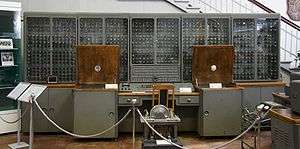Ural (computer)

Ural (Russian: Урал) is a series of mainframe computers built in the former Soviet Union.
History
The Ural was developed at the Electronic Computer Producing Manufacturer of Penza in the Soviet Union and was produced between 1956 and 1964. The computer was widely used in the 1960s, mainly in the socialist countries, though some were also exported to Western Europe and Latin America.
When the University of Tartu received a new computer, its old computer, the Ural 1, was moved to a science-based secondary school, the Nõo Reaalgümnaasium. That event[1] took place in 1965 and made the Nõo Reaalgümnaasium the very first secondary school in the Soviet Union to own its very own computer. The name of the computer was also used to coin the very first name for "computer" in Estonian, raal, in use until the 1990s until it was replaced by the word arvuti ("computer").
Attributes
Models Ural-1 to Ural-4 were based on vacuum tubes (valves), with the hardware being able to perform 12,000 floating-point calculations per second. One word consisted of 40 bits and was able to contain either one numeric value or two instructions. Ferrite core was used as operative memory beginning with the Ural-2.[2] A new series (Ural-11, Ural-14, produced between 1965 and 1971) was based on semiconductors.
It was able to perform mathematical tasks at computer centres, industrial facilities and research facilities. The device occupied approximately 90-100 square metres of space. The computer ran on three-phase electric power and had a three-phase magnetic voltage stabiliser with 30kVA capacity.
The main units of the system were: keyboard, controlling-reading unit, input punched tape, output punched tape, printer, magnetic tape memory, ferrite memory, ALU (arithmetical logical unit), CPU (central processing unit), and power supply.
Models[3]
- Ural-1 - 1956
- Ural-2 - 1959
- Ural-3 - 1964
- Ural-4 - 1962
- Ural-11 - 1965
- Ural-14 - 1965
- Ural-16 - 1969
Trivia
- Charles Simonyi, who was the second Hungarian in space, stated that he would take old paper tapes from his Soviet-built Ural-2 computer into space with him: he kept them to remind him of his past.[4]
See also
- Bashir Rameev, chief designer of the Ural series
References
- ↑ http://nrg.tartu.ee/koolist/ajalugu(in+Estonian)
- ↑ Proydakov, Eduard. "Electronic Digital Computer URAL-2 (Урал-2)". Russian Virtual Computer Museum. Retrieved Jan 26, 2018.
- ↑ Proydakov, Eduard. "Ural Family of Computers". Russian Virtual Computer Museum. Retrieved Jan 26, 2018.
- ↑ http://go.sosd.com/servlet/nrp?cmd=sty&cid=RIM&pgn=1&ino=1061860&cat=Science&lno=1
External links
| Wikimedia Commons has media related to Ural-1. |
- Sutton, Anthony (2014). The Best Enemy Money Can Buy. p. 59. Retrieved Jan 26, 2018.